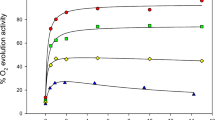Abstract
ATOMIC hydrogen is one of the simplest chemical reagents. Its structure can be described in exact theoretical terms. In aqueous solution it interacts only relatively weakly with the solvent. It is neutral and thus not influenced by ionic effects in its reaction with specific substrates. Therefore its reactions are of interest from the point of view of fundamental chemical kinetics in aqueous solutions. Recently, a method has been established for the investigation of the quantitative aspects of the reactivity of atomic hydrogen with various substrates dissolved in aqueous solutions1. Using a high-frequency electrode-less discharge to dissociate pure hydrogen gas into hydrogen-atoms and passing these under carefully controlled conditions into aqueous solution, it was shown that the reactive species is identical in its reactions with hydrogen-atoms produced by ionizing radiations or by ultra-violet light2. Therefore these reactions serve to elucidate also, independently, some aspects of the mechanism of the action of ionizing radiations or ultra-violet light on such systems. In this method, however, hydrogen atoms are the only reactive species present so that their specific action may be examined separately. The reactions of simple substrates (inorganic ions1,2; their inorganic complexes3; simple organic solutes4) were used to establish details of the reactivity of hydrogen atoms. The work was extended to enzymes (chymotrypsin5a, trypsin5b, ribonuclease5c) to elucidate the action on biologically interesting substrates.
Similar content being viewed by others
References
a Czapski, G., and Stein, G., Nature, 182, 598 (1958); J. Phys. Chem., 63, 850 (1959); b, ibid., 64, 219 (1960); c, Israel J. Chem., 2, 15 (1964).
a, Czapski, G., Jortner, J., and Stein, G., J. Phys. Chem., 65, 956, 960 (1961). b, Navon, G., and Stein, G., ibid., 69, 1384 (1965).
a, Navon, G., and Stein, G., J. Phys. Chem., 69, 1390 (1965); b, (to be published). Navon, G., Ph.D. thesis, Jerusalem (1965).
a, Czapski, G., Rabani, J., and Stein, G., Trans. Faraday Soc., 58, 2160 (1962). b, Navon, G., and Stein, G., Israel J. Chem., 2, 151 (1964).
a, Mee, L. K., Navon, G., and Stein, G., Nature, 204, 1056 (1964); b, Biochim. Biophys. Acta, 104, 151 (1965). c, Holmes, B. F., Navon, G., and Stein, G. (to be published).
Margoliash, E., Biochem. J., 56, 529, 535 (1954); Biochem. Preparations, 5, 33 (J. Wiley and Sons, Inc., N.Y., 1957).
Rabani, J., and Stein, G., Rad. Res., 17, 327 (1962).
Gordon, S., Hart, E. J., Matheson, M. S., Rabani, J., and Thomas, J. K., Disc. Faraday Soc., 36, 193 (1963). Matheson, M. S., Rad. Res., Supp., 4, 1 (1964).
Sutin, N., Nature, 190, 438 (1961). Sutin, N., and Christman, D. R., J. Amer. Chem. Soc., 83, 1773 (1961).
Margoliash, E., in Enzyme Models and Enzyme Structure, Brookhaven Symp. Biol., 15, 266 (1962).
Author information
Authors and Affiliations
Rights and permissions
About this article
Cite this article
CZAPSKI, G., FROHWIRTH, N. & STEIN, G. Action of Atomic Hydrogen on Ferri-Cytochrome c in Aqueous Solution. Nature 207, 1191–1192 (1965). https://doi.org/10.1038/2071191a0
Published:
Issue Date:
DOI: https://doi.org/10.1038/2071191a0
- Springer Nature Limited
This article is cited by
-
Action of Atomic Hydrogen on Aqueous Bacteriophage T7
Nature (1968)
-
Action of Atomic Hydrogen on Ribonuclease in Aqueous Solution
Nature (1967)





